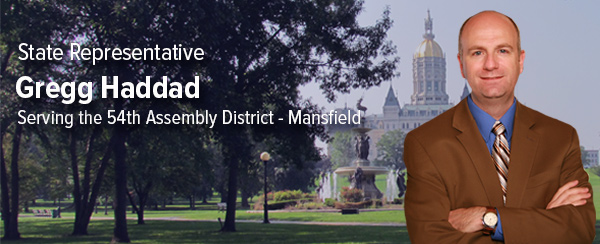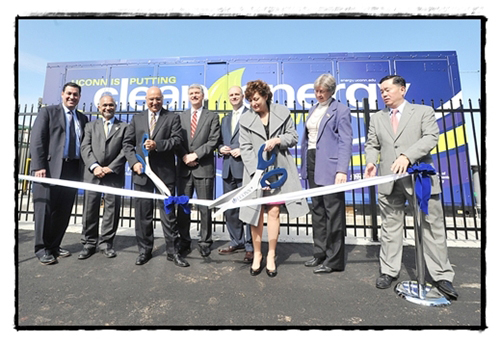
April 27, 2012
By Michelle Firestone, Chronicle staff writer
STORRS — As part of its ongoing commitment to sustainability, the University of Connecticut unveiled its first fuel cell power plant at the Depot campus Thursday afternoon.
The 400-kw plant was funded by a $1 million federal stimulus grant from the Connecticut Clean Energy Finance and Investment Authority (CEFIA).
It was commissioned by UConn officials, legislators, UTC Power and CEFIA during a ceremony Thursday.
“I’m so proud to be a part of a university community that values the environment as much as we do,” said state Rep. Gregory Haddad, D-Mansfield, one of the event speakers.
UConn is the second school in the state to put a fuel cell power plant into operation.
According to CEFIA employees, a 400-kw system is being developed at Eastern Connecticut State University and is expected to be in operation this spring. A third, 1.4-mw system, is already in operation at Central Connecticut State University. “I think together, we can lead Connecticut, and the country, into a sustainable future,” said Joe Triompo, vice president and general manager of UTC Power, which installed the system.
The system combines hydrogen fuel and oxygen to produce electricity, heat and water. It will provide hot water to variousbuildings at the Depot campus, such as the Longley Building and the Center for Clean Energy Engineering, as well as air-condition and cool those buildings.
It will be a “test pad” for a microgrid that legislators hope to create in response to the freak October snowstorm and Tropical Storm Irene, storms that left millions without power in Connecticut, some for more than a week.
The micro-grid would produce electricity for homeowners in the event of a natural disaster.
“What we realized is that we need energy security,” said Senate President Pro Tempore Donald Williams Jr., D-Brooklyn.
For Prabhakar Singh, director of the Center for Clean Energy Engineering and a UTC endowed chair professor in fuel-cell technology, and Dean of Engineering Mun Choi, the energy conversion system is an opportunity for students to learn about the technology.
The system will be used by various different disciplines across campus, including chemical engineering, electrical engineering, materials science and even business.
“It’s a platform for education,” said Choi, who will soon be the interim provost, replacing Peter Nicholls.
By using the fuel cell, students will become “more competitive and more knowledgeable in the marketplace,” said Singh.
“This is a great opportunity for us to show what the university can do to help bring business to Connecticut,” said Haddad.
He and Williams helped make the project a reality through their work in legislature.
The installation comes on the heels of a climate action plan signed by UConn President Susan Herbst last month.
The aim of the plan, which includes more than 200 commitments, is to achieve carbon-neutrality on the Storrs campus by 2050.
“The fuel cell, as you see here today, is vital to this mission,” Herbst said Thursday.
According to information released by UConn, the fuel cell will prevent the release of more than 831 metric tons of carbon dioxide per year, the equivalent of planting 192 acres of forest.
Nearly 3.9 million gallons of water annually will be conserved through the fuel cell, enough water to fill up almost six Olympic swimming pools.
Another environmental benefit of fuel-cell technology is the reduction of nitrogen oxide. Compared to conventional power plants, this equates to removing 110 cars from the road.
UConn has already received numerous distinctions for its sustainable initiatives, including being named as one of the top 20 most environmentally friendly campuses in the country by the Sierra Club and one of the most eco-friendly campuses on Earth, according to a sustainability survey of 178 universities in 42 countries, conducted by Universitas Indonesia.
“It really is a significant milestone in our climate action plan,” UConn Environmental Policy Director Richard Miller said of the project.
Miller has been involved in various sustainable initiatives on campus.
Currently, the engineering departments create bio-diesel fuel that is used in many of the university vehicles. Also, UConn recently received an electric van and installed a charging station.
The van is used to make various supply deliveries to the Depot and main campuses in Storrs.
With the progress UConn has made towards its climate action plan, it is looking ahead to future initiatives.
University officials are in the process of investigating what other UConn campuses they can install other fuel cell power plants on.
“All of the campuses are currently being looked at for the feasibility,” said Singh.

University of Connecticut President Susan Herbst, third from right, cuts the ribbon in front of UConn’s first fuel cell power plant on the Depot campus on Thursday. With her, from left, are Bryan Garcia, president of the Connecticut Clean Energy Finance and Investment Authority; Prabhakar Singh, director of the Center for Clean Energy Engineering; Joe Triompo, vice president and general manager of UTC Power; Senate President Pro Tempore Donald Williams Jr., D-Brooklyn; state Rep. Gregory Haddad, D-Mansfield; Tricia Bergman, associate director of the Center for Clean Energy Engineering; and Dean of Engineering Mun Choi. Roxanne Pandolfi
Legislative Office Building, Room 4027
Hartford, CT 06106-1591
(860) 240-8585 | 1-800-842-8267
Gregory.Haddad@cga.ct.gov

